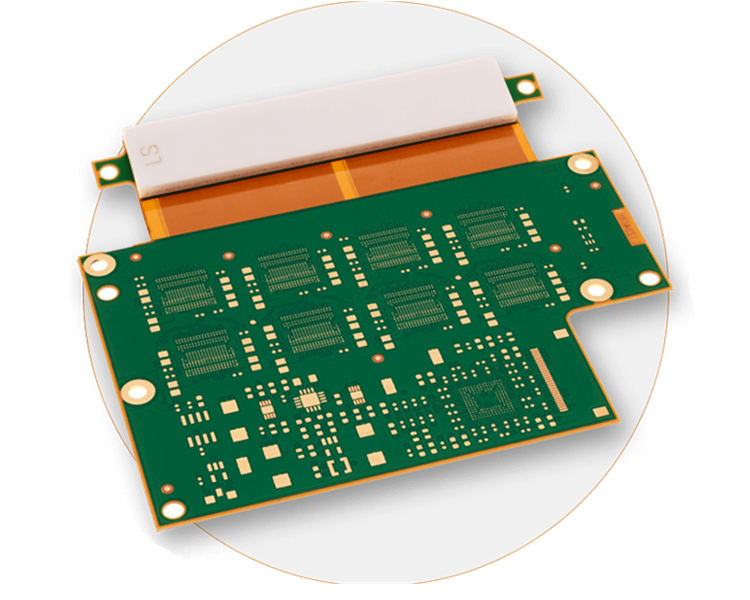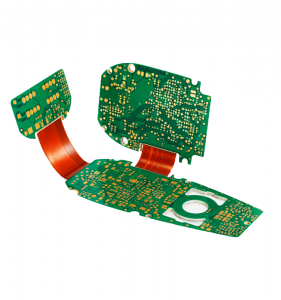
The pros and cons of rigid-flex and traditional rigid PCBs will be compared to help you select the optimal technology for your next electronic system design.
The printed circuit board (PCB) is the foundational element of electronic devices. In its most basic form, a PCB consists of a non-conductive plate with conductive traces on the surface, as illustrated in Figure 1. All of the electronic components, including integrated circuits (ICs), capacitors, resistors, and inductors, are mounted to the surface of the PCB and electrically connected by the conductive traces to achieve the desired functionality.
Printed Circuit Board Types
Printed circuit boards can be categorized into multiple types. Each type is designed for specific purposes, requirements, and applications. For example, we can divide them by their physical form factor and flexibility, number of copper layers, and/or special functional characteristics. Table 1 provides examples of the different PCB options.
Table 1. Examples of PCB Types and Options
| Form Factor | Copper Layers | Characteristics |
| Rigid | Single-sided | High-frequency RF |
| Rigid-flex | Double-sided | Gold finger |
| Flex | Multi-layer | High-density interconnect |
In this article, we will focus on the two main types of PCB form factors—rigid and rigid-flex—with the goal of helping you make the best decision when designing your next product.
Traditional Rigid Printed Circuit Boards
Traditional rigid printed circuit boards are most commonly made from a glass-reinforced epoxy laminate material known as FR4. These ubiquitous green boards with copper traces are seen in numerous electronic applications, such as the computer motherboard shown in Figure 2.
These boards can be one-sided, double-sided, or multilayered with multiple copper trace layers separated by insulating layers, enabling more complex electronic circuits. Utilized across diverse electronic devices, from consumer electronics to industrial machines and aerospace applications, let’s take a look at some key features of traditional rigid PCBs.
Excellent Reliability
Constructed using FR4, a flame-retardant epoxy, providing superb electrical insulation, high heat resistance, low water absorption, and compatibility with lead-free elements.
Superior Mechanical Processability
FR4 material allows for the drilling of small holes without cracking and easy profiling and punching for custom shapes. With support for multiple laminations at high temperatures without substrate or copper trace damage, rigid PCBs can be produced with up to 100 copper layers.
Cost-Effectiveness
FR4 material is common and inexpensive compared to materials like ceramic, polyimide, or metal-based alternatives, making FR4 PCBs widely preferred in cost-sensitive consumer electronics.
Compatibility with Other Materials
FR4 materials can be combined with ceramics, polyimide, or reinforced for enhanced performance, such as high TG FR4 material or high-speed FR4 material.
Established Manufacturing Process
With years of widespread use, the manufacturing process for FR4 PCBs is mature, ensuring expertise in drilling, copper plating, etching, soldering, testing, and surface treatment. Manufacturers have mastered these processes, and production lines are optimized for FR4 circuit board manufacturing.
Understanding Rigid-Flex Printed Circuit Boards
As the name suggests, rigid-flex printed circuit boards combine rigidity and flexibility in their structure. These boards can be easily bent or flexed at the flexible parts. A key feature of rigid-flex PCBs is their ability to provide a reliable platform for mounting complex electronic components while allowing for bending.
Let’s examine some key characteristics of rigid-flex PCBs.
Physical Flexibility
The flexibility of rigid-flex PCBs enables the combination of intricate electronic assemblies by soldering high-density components on the rigid part while keeping the flexible part devoid of electronic components.
Space-saving
By replacing multiple FR4 PCBs and cables with a single rigid-flex PCB, these circuits significantly reduce weight. As a result, they find application in lightweight electronic devices like cameras, wearables, and drones.
Lightweight
Substantially reduces weight compared to multiple FR4 PCBs and cables, making them ideal for lightweight electronic applications like cameras, wearables, and drones.
Reliability
Rigid-flex PCBs offer superior stability compared to cables with plugs, ensuring consistent connection due to the wires being enclosed within the circuit board and covered by a thin, flexible layer. Therefore, they are widely used in highly reliable applications like military, aviation, and aerospace.
Excellent Electrical Properties
Unlike cable connections between multiple PCBs, rigid-flex PCBs directly link circuits, facilitating signal transmission without delay or interruption, resulting in excellent electrical properties.
Mechanical Strength
Rigid-flex PCBs exhibit robustness and mechanical strength, making them suitable for applications where physical stress on the circuit board is expected.
Choosing Between Rigid-Flex and Traditional PCBs
There is no single PCB solution that is ideal for all applications. The pros and cons of rigid-flex and traditional rigid PCB technologies must be considered (Figure 4).
Figure 4. Rigid-flex PCBs vs. traditional rigid PCBs. Images used courtesy of Viasion Technology
The decision between rigid-flex and traditional PCBs hinges on multiple factors:
- Flexibility Requirements:Rigid-flex PCBs suit applications requiring more flexibility due to space constraints or movement.
- Weight Considerations:Rigid-flex PCBs offer reduced weight, beneficial for portable devices and aerospace systems.
- Reliability:Rigid-flex PCBs provide superior reliability under challenging conditions.
- Design Efficiency:Traditional PCBs simplify complex designs, while rigid-flex PCBs streamline three-dimensional usage.
- Space Efficiency: Rigid-flex PCBs require less space compared to traditional PCBs with extra cables and connectors.
- Cost and Lead Time:Traditional PCBs are usually more cost-effective and have shorter lead times compared to rigid-flex PCBs, making them ideal for large-scale production.
Helping You Choose the Right PCB Solution
When choosing the right substrate for your next design, consulting PCB manufacturers with experience in both rigid and rigid-flex construction, like Viasion Technology, can be beneficial. They can provide advice on design feasibility and cost-effectiveness. Collaboration with manufacturing teams can provide tailored solutions that cater to your specific PCB designs and constraints.


